D. Perovich1,2, W. Meier3, M. Tschudi4, S. Farrell5, S. Gerland6, S. Hendricks 7
1ERDC – CRREL, 72 Lyme Road, Hanover USA
2Thayer School of Engineering, Dartmouth College, Hanover, NH, USA
3NASA Goddard Space Flight Center, Greenbelt, MD, USA
4Aerospace Engineering Sciences, University of Colorado, Boulder, CO, USA
5NOAA Earth System Science Interdisciplinary Center, University of Maryland, College Park, MD, USA
6Norwegian Polar Institute, Fram Centre, Tromsø, Norway
7Alfred Wegener Institute, Bremerhaven, Germany
Highlights
- The September 2015 Arctic sea ice minimum extent was 4.63 million km2, 29% less than the 1981-2010 average minimum ice extent and the fourth lowest value in the satellite record (1979-2015).
- The lowest maximum ice extent in the satellite record (1979-2015) occurred on 25 February 2015, 15 days earlier than the 1981-2010 average (12 March); at 14.54 million km2, it was 7% below the 1981-2010 average.
- In March 2015, multiyear ice (>1 years old) and first-year ice were 31% and 69% of the ice cover, respectively, differing little from the 2014 values.
- Multi-year sea ice continues to dominate the central Arctic Ocean, with a mean ice thickness that remains around 3.2 m.
Sea Ice Extent
Sea ice extent is the primary descriptor of the state of the Arctic sea ice cover. Satellite-based passive microwave instruments have been used to determine sea ice extent since 1979. There are two months each year that are of particular interest: September, at the end of summer, when the ice reaches its annual minimum extent, and March, at the end of winter, when the ice typically is at its maximum extent. Maps of monthly average ice extents in March 2015 and September 2015 are shown in Fig. 4.1.
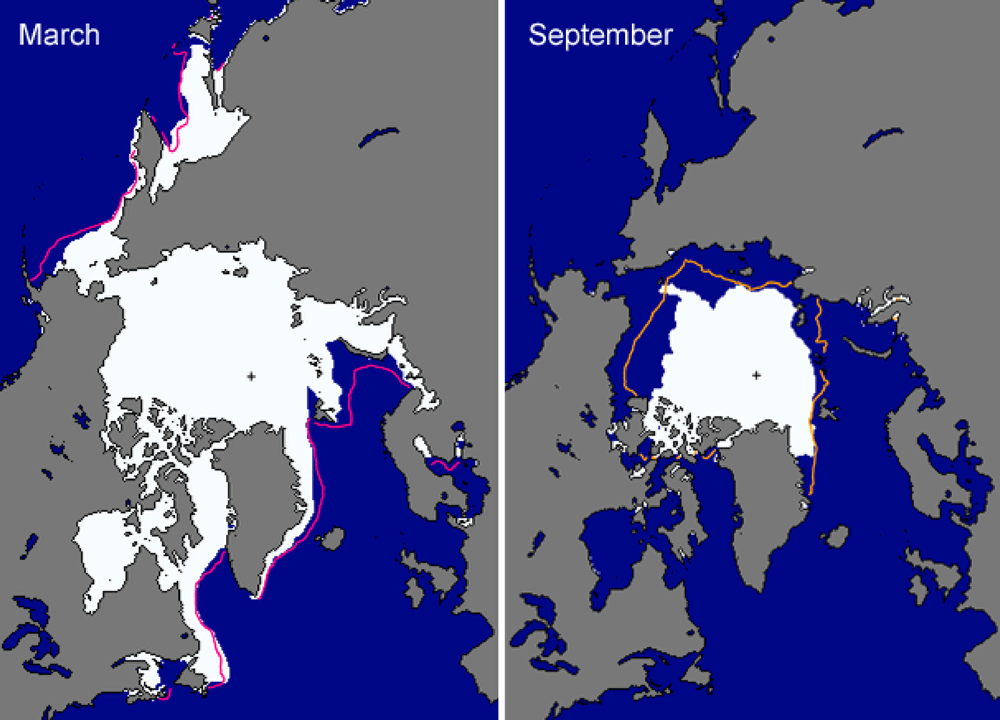

Based on estimates produced by the National Snow and Ice Data Center (NSIDC) the Arctic sea ice cover reached a minimum annual extent of 4.41 million km2 on September 11, 2015. This was substantially higher (1.02 million km2, 30%) than the record minimum of 3.39 million km2 set in 2012. However, the 2015 summer minimum extent was still 1.81 million km2 (29%) less than the 1981-2010 average minimum ice extent and was 0.62 million km2 (12%) less than the 2014 minimum. On February 25, 2015 Northern Hemisphere ice extent reached a maximum value of 14.54 million km2, 7% below the 1981-2010 average and the lowest maximum value in the satellite record. Also notable, the maximum extent occurred 15 days earlier than the 1981-2010 average (12 March) and was the second earliest of the satellite record.
Sea ice extent has decreasing trends in all months and virtually all regions (the exception being the Bering Sea during winter). The September monthly average trend for the entire Arctic Ocean is now -13.4% per decade relative to the 1981-2010 average (Fig. 4.2). Trends are smaller during March (-2.6% per decade), but are still decreasing at a statistically significant rate.
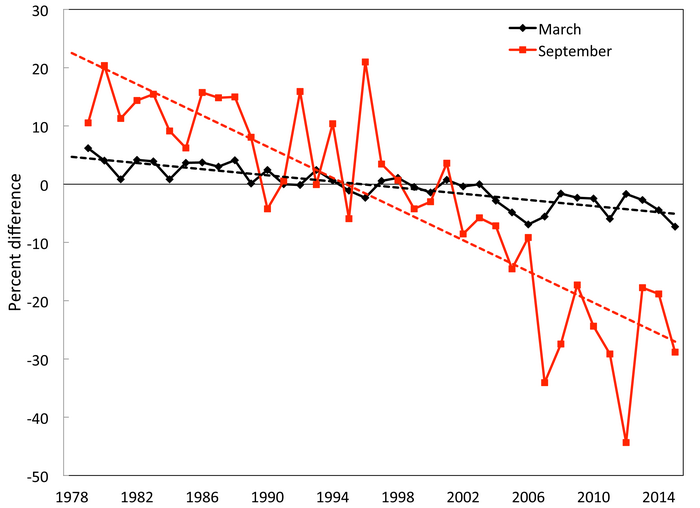

Before 2007, there had never been a March to September loss of more than 10 million km2 of ice but now such large losses are not unusual. This year, 10.13 million km2 of ice was lost between the March maximum and September minimum extent, typical of summer losses since 2007.
Age of the Ice
The age of sea ice is another descriptor of the state of the sea ice cover. It serves as an indicator for ice physical properties, including surface roughness, melt pond coverage and thickness. Older ice tends to be thicker and thus more resilient to changes in atmospheric and oceanic forcing compared to younger ice. The age of the ice is determined using satellite observations and drifting buoy records to track ice parcels over several years (Tschudi et al. 2010; Maslanik et al. 2011). This method has been used to provide a record of the age of the ice since the early 1980s (Tschudi et al. 2015).
The oldest ice (>4 years old) continues to make up a small fraction of the Arctic ice pack in March, when the sea ice extent has been at its maximum in most years of the satellite record (Figs. 4.3a and 4.3c). In 1985, 20% of the ice pack was very old ice (Fig. 3b), but in March 2015 old ice only constituted 3% of the ice pack (Fig. 3c). Furthermore, we note that first-year ice now dominates the ice cover, comprising ~70% of the March 2015 ice pack, compared to about half that in the 1980s. Note that the age distribution of the ice cover in March 2015 was the same as it was in February 2015, when maximum ice extent occurred. Given that older ice tends to be thicker, the sea ice cover has transformed from a strong, thick pack in the 1980s to a more fragile, thin and younger pack in recent years. The thinner, younger ice is more vulnerable to melting out in the summer, resulting in lower minimum ice extents. The distribution of ice age in March 2015 was similar to that in March 2014 (Fig. 4.3a).
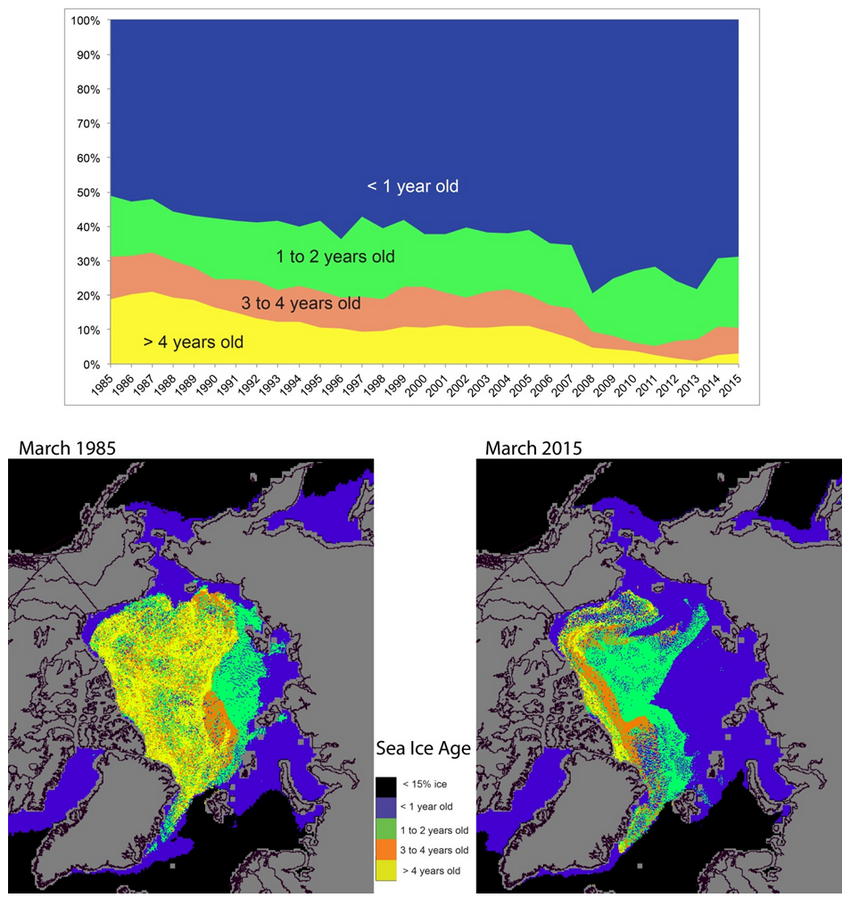

Note that most of the oldest ice accumulates along the coast of North Greenland and the Queen Elizabeth Islands of the Canadian Arctic Archipelago, and much of this ice has resided in this area for several years. In 2015, as in most years, ice transport patterns resulted in the movement of the old ice from this area into the Beaufort Sea. The lack of ice older than one year in the eastern Arctic (on the Eurasian side of the Arctic Basin) foreshadows its susceptibility to melt out in summer. The ice in the southern Beaufort and Chukchi seas has also melted completely in the past few summers, with even the oldest ice not surviving the season.
Sea Ice Thickness
Observations of sea ice thickness and volume from multiple sources have revealed the continued decline of the Arctic sea ice pack over the last decade (Kwok and Rothrock 2009; Laxon et al. 2013; Kwok and Cunningham 2015). These changes have impacts on the regional Arctic and sub-Arctic climate, environment and ecosystems. To understand these impacts, as the Arctic transitions from a predominantly multi-year ice pack to a seasonal ice cover (Fig. 4.3), continued monitoring of the state of the ice pack is required. Towards this end, multiple satellite, airborne and in-situ campaigns continue to obtain measurements of key sea ice properties, which are of particular interest for understanding the inter-annual variability of the ice pack. The NASA Operation IceBridge, a multi-instrumented aircraft mission, has been making annual surveys of sea ice since 2009 in the western Arctic (on the North American side of the Arctic Basin) at the end of the winter growth period. Meanwhile, the ESA CryoSat-2 satellite has been measuring sea ice freeboard (from which sea ice thickness and volume are derived) since 2010 (Tilling et al., 2015).
Figure 4.4a shows consistency between the independent CryoSat-2 and IceBridge estimates of Arctic sea ice thickness in March/April 2015, and with the map of ice age (Fig. 3c). The oldest ice north of Greenland and the Canadian Arctic Archipelago remains thicker than 3 m. Also, there is a strong gradient to thinner, seasonal ice in the Canada Basin and the eastern Arctic Ocean, where ice is between 1 m and 2 m thick. Operation IceBridge also provides details of the inter-annual variability in the sea ice thickness distribution over a seven-year period from March/April 2009 to March/April 2015 (Figs. 4.4b and 4.4c). Sea ice in the central Arctic is predominantly multi-year in nature, with mean and modal ice thickness remaining stable at around 3.2 m and 2.5 m, respectively (Fig. 4.4b). Richter-Menge and Farrell (2013) showed that sea ice in the Beaufort and Chukchi seas region is more seasonal in nature and is a mix of multiyear (~25%) and first-year ice (~75%). Here, the inter-annual variability of the ice thickness distribution over the last seven years has been more variable (Fig. 4.4c), with mean and modal ice thickness around 2.1 m and 1.8 m, respectively. Year-to-year variability is primarily related to the presence and location of a band of multi-year sea ice in the southern Beaufort Sea (Richter-Menge and Farrell 2013).
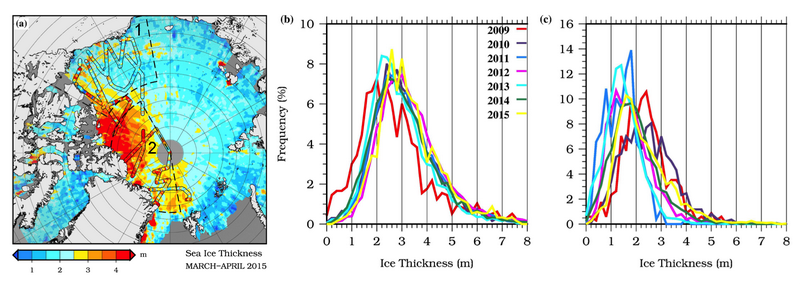

Summer Melt
The impact of seasonal melting on ice conditions is illustrated further in Fig. 4.5, which compares observations of total summer surface and bottom melt in the Beaufort Sea and in the vicinity of the North Pole between 1959 and 2015. These observations were made either by personnel at drifting ice stations or by autonomous buoys (Perovich and Richter-Menge 2015). Data from 1959 in the Beaufort Sea show less melting overall than in the past decade. Between the end of May and mid-August 2015 at the Beaufort Sea site there was 2.05 m of total melt (0.55 m at the surface, 1.50 m at the bottom), enough to completely melt the multiyear floe where the measurements were made. In contrast, in 2015 at the North Pole site, there was 1.06 m of melt (0.56 m at the surface, 0.50 m at the bottom) between the beginning of melt at this location in early June and the end of the melt season in late-September.
The time series of summer melting indicates that, over the past decade, there has been a significant increase in the amount of bottom melting in the Beaufort Sea. In 2007, 2008, 2014 and 2015, at least 1.5 m of bottom melting occurred, more than twice as much as surface melting and enough to remove much of the multiyear ice in the region. This is in contrast to years prior to 2007, when surface melting was typically greater than bottom melting. Near the North Pole, overall melting was consistently less than in the Beaufort Sea and the multiyear ice never completely melted. On average, there is significantly more surface melt and bottom melt at the Beaufort Sea sites than at the North Pole. The greater amount of bottom melting in the Beaufort Sea, on both an inter-annual and regional basis, is a direct consequence of solar heating of the upper ocean (Perovich and Richter-Menge 2015; see also the essay on Sea Surface Temperature). Considerable inter-annual variability is evident in both surface and bottom melting for the Beaufort Sea and North Pole sites.
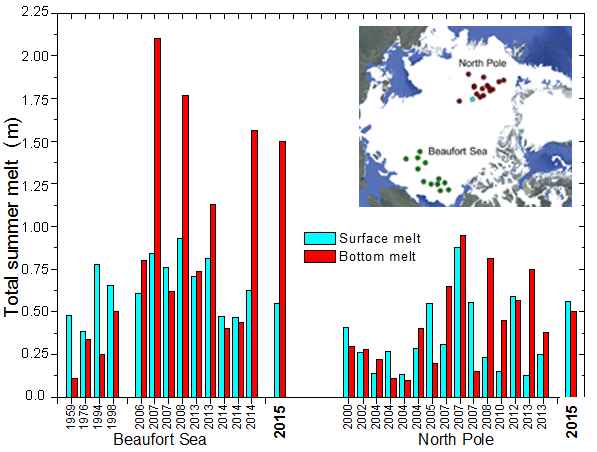

References
Kwok, R., and G. F. Cunningham, 2015: Variability of Arctic sea ice thickness and volume from CryoSat-2, Phil. Trans. Royal Soc. London A: Math., Phys. Eng. Sci., 373, 2045, doi.org/10.1098/rsta.2014.0157.
Kwok, R., and D. A. Rothrock, 2009: Decline in Arctic sea ice thickness from submarine and ICESat records: 1958-2008, Geophys. Res. Lett., 36, doi:10.1029/2009GL039035.
Laxon, S. W., K. A. Giles, A. L. Ridout, D. J. Wingham, R. Willatt, R. Cullen, R. Kwok, A. Schweiger, J. Zhang, C. Haas, S. Hendricks, R. Krishfield, N. Kurtz, S. L. Farrell, M. Davidson, 2013: CryoSat estimates of Arctic sea ice Volume, Geophys. Res. Lett., 40, doi:10.1002/grl.50193.
Maslanik, J., J. Stroeve, C. Fowler, and W. Emery, 2011: Distribution and trends in Arctic sea ice age through spring 2011. Geophys. Res. Lett., 38, doi:10.1029/2011GL047735.
NSIDC at nsidc.org/data/seaice_index.
Perovich, D. K. and J. A. Richter-Menge, Regional variability in sea ice melt in a changing Arctic, 2015: Proc. Royal Soc., 373, doi.org/10.1098/rsta.2014.0165.
Richter-Menge, J., and S. L. Farrell, 2013: Arctic sea ice conditions in spring 2009 – 2013 prior to melt, Geophys. Res. Lett., 40, 5888-5893, doi: 10.1002/2013GL058011.
Tilling, R. L., A. Ridout, A. Shepherd, and D. J. Wingham, 2015; Increased Arctic sea ice volume after anomalously low melting in 2013. Nat. Geosci., 8, 643-646. doi:10.1038/ngeo2489.
Tschudi, M. A., C. Fowler, J. A. Maslanik, and J. A. Stroeve, 2010: Tracking the movement and changing surface characteristics of Arctic sea ice. IEEE J. Sel. Topics Earth Obs. and Rem. Sens., 3, doi: 10.1109/JSTARS.2010.2048305.
Tschudi, M., C. Fowler, and J. Maslanik, 2015: EASE-Grid Sea Ice Age, Version 2. Boulder, Colorado USA. NASA National Snow and Ice Data Center Distributed Active Archive Center, doi.org/10.5067/1UQJWCYPVX61.
December 15, 2015